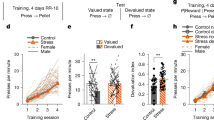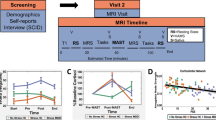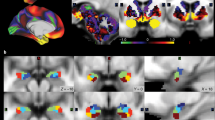Abstract
Two research lines argue for rapid stress-induced reallocations of neural network activity involving the amygdala. One focuses on the role of norepinephrine (NE) in mediating a shift towards the salience network and improving vigilance processing, whereas the other focuses on the role of cortisol in enhancing automatic, habitual responses. It has been suggested that the mineralocorticoid receptor (MR) is critical in shifting towards habitual responses, which are supported by the dorsal striatum. However, until now it remained unclear whether these two reallocations of neural recourses might be part of the same phenomenon and develop immediately after stress onset. We combined methods used in both approaches and hypothesized specifically that stress would lead to rapidly enhanced involvement of the striatum as assessed by amygala-striatal connectivity. Furthermore, we tested the hypothesis that this shift depends on cortisol interacting with the MR, by using a randomized, placebo-controlled, full-factorial, between-subjects design with the factors stress and MR-blockade (spironolactone). We investigated 101 young, healthy men using functional magnetic resonance imaging after stress induction, which led to increased negative mood, heart rate, and cortisol levels. We confirmed our hypothesis by revealing a stress-by-MR-blockade interaction on the functional connectivity between the centromedial amygdala (CMA) and the dorsal striatum. Stress rapidly enhanced CMA-striatal connectivity and this effect was correlated with the stress-induced cortisol response, but required MR availability. This finding might suggest that the stress-induced shift described by distinct research lines might capture different aspects of the same phenomenon, ie, a reallocation of neural resources coordinated by both NE and cortisol.
Similar content being viewed by others
Log in or create a free account to read this content
Gain free access to this article, as well as selected content from this journal and more on nature.com
or
References
Amunts K, Kedo O, Kindler M, Pieperhoff P, Mohlberg H, Shah NJ et al (2005). Cytoarchitectonic mapping of the human amygdala, hippocampal region and entorhinal cortex: intersubject variability and probability maps. Anat Embryol 210: 343–352.
Arnsten AFT (2009). Stress signalling pathways that impair prefrontal cortex structure and function. Nat Rev Neurosci 10: 410–422.
Aston-Jones G (1985). Behavioral functions of locus coeruleus derived from cellular attributes. Physiol Psychol 13: 118–126.
Brown VM, LaBar KS, Haswell CC, Gold AL, Mid-Atlantic MW, McCarthy G et al (2014). Altered resting-state functional connectivity of basolateral and centromedial amygdala complexes in posttraumatic stress disorder. Neuropsychopharmacology 39: 361–369.
Cornelisse S, Joels M, Smeets T (2011). A randomized trial on mineralocorticoid receptor blockade in men: effects on stress responses, selective attention, and memory. Neuropsychopharmacology 36: 2720–2728.
de Kloet ER, Joels M, Holsboer F (2005). Stress and the brain: rom adaptation to disease. Nat Rev Neurosci 6: 463–475.
Etkin A, Prater KE, Schatzberg AF, Menon V, Greicius MD (2009). Disrupted amygdalar subregion functional connectivity and evidence of a compensatory network in generalized anxiety disorder. Arch Gen Psychiatry 66: 1361–1372.
Fox MD, Raichle ME (2007). Spontaneous fluctuations in brain activity observed with functional magnetic resonance imaging. Nat Rev Neurosci 8: 700–711.
Fudge JL, Kunishio K, Walsh P, Richard C, Haber SN (2002). Amygdaloid projections to ventromedial striatal subterritories in the primate. Neuroscience 110: 257–275.
Han J-S, McMahan RW, Holland P, Gallagher M (1997). The role of an amygdalo-nigrostriatal pathway in associative learning. J Neurosci 17: 3913–3919.
Hariri AR, Mattay VS, Tessitore A, Kolachana B, Fera F, Goldman D et al (2002). Serotonin transporter genetic variation and the response of the human amygdala. Science 297: 400–403.
Henckens MJAG, van Wingen GA, Joels M, Fernandez G (2011). Time-dependent corticosteroid modulation of prefrontal working memory processing. Proc Natl Acad Sci USA 108: 5801–5806.
Herman JP, McKlveen JM, Solomon MB, Carvalho-Netto E, Myers B (2012). Neural regulation of the stress response: glucocorticoid feedback mechanisms. J Med Biol Res 45: 292–298.
Hermans EJ, Henckens MJAG, Joëls M, Fernández G (2014). Dynamic adaptation of large-scale brain networks in response to acute stressors. Trends Neurosci 37: 304–314.
Hermans EJ, van Marle HJF, Ossewaarde L, Henckens MJAG, Qin S, van Kesteren MTR et al (2011). Stress-related noradrenergic activity prompts large-scale neural network reconfiguration. Science 334: 1151–1153.
Joels M, Baram TZ (2009). The neuro-symphony of stress. Nat Rev Neurosci 10: 459–466.
Joëls M, Sarabdjitsingh RA, Karst H (2012). Unraveling the time domains of corticosteroid hormone influences on brain activity: rapid, slow, and chronic modes. Pharmacol Rev 64: 901–938.
Johansen JP, Cain CK, Ostroff LE, LeDoux JE (2011). Molecular mechanisms of fear learning and memory. Cell 147: 509–524.
Karst H, Berger S, Erdmann G, Schutz G, Joels M (2010). Metaplasticity of amygdalar responses to the stress hormone corticosterone. Proc Natl Acad Sci 107: 14449–14454.
Kim JJ, Lee HJJ, Han JS, Packard MG (2001). Amygdala is critical for stress-induced modulation of hippocampal long-term potentiation and learning. J Neurosci 21: 5222–5228.
LeDoux J, Iwata J, Cicchetti P, Reis D (1988). Different projections of the central amygdaloid nucleus mediate autonomic and behavioral correlates of conditioned fear. J Neurosci 8: 2517–2529.
McDonald AJ (1998). Cortical pathways to the mammalian amygdala. Prog Neurobiol 55: 257–332.
Muehlhan M, Lueken U, Wittchen H-U, Kirschbaum C (2011). The scanner as a stressor: Evidence from subjective and neuroendocrine stress parameters in the time course of a functional magnetic resonance imaging session. Int J Psychophysiol 79: 118–126.
Otte C, Moritz S, Yassouridis A, Koop M, Madrischewski AM, Wiedemann K et al (2007). Blockade of the mineralocorticoid receptor in healthy men: effects on experimentally induced panic symptoms, stress hormones, and cognition. Neuropsychopharmacology 32: 232–238.
Pace TWW, Spencer RL (2005). Disruption of mineralocorticoid receptor function increases corticosterone responding to a mild, but not moderate, psychological stressor. Am J Physiol Endocrinol Metab 288: E1082–E1088.
Packard MG, Teather LA (1998). Amygdala modulation of multiple memory systems: hippocampus and caudate-putamen. Neurobiol Learn Mem 69: 163–203.
Packard MG, Wingard JC (2004). Amygdala and ‘emotional’ modulation of the relative use of multiple memory systems. Neurobiol Learn Mem 82: 243–252.
Poser BA, Versluis MJ, Hoogduin JM, Norris DG (2006). BOLD contrast sensitivity enhancement and artifact reduction with multiecho EPI: parallel-acquired inhomogeneity-desensitized fMRI. Magn Reson Med 55: 1227–1235.
Pruessner JC, Kirschbaum C, Meinlschmid G, Hellhammer DH (2003). Two formulas for computation of the area under the curve represent measures of total hormone concentration versus time-dependent change. Psychoneuroendocrinology 28: 916–931.
Rimmele U, Besedovsky L, Lange T, Born J (2013). Blocking mineralocorticoid receptors impairs, blocking glucocorticoid receptors enhances memory retrieval in humans. Neuropsychopharmacology.
Roozendaal B, Hui GK, Hui IR, Berlau DJ, McGaugh JL, Weinberger NM (2006). Basolateral amygdala noradrenergic activity mediates corticosterone-induced enhancement of auditory fear conditioning. Neurobiol Learn Mem 86: 249–255.
Roy AK, Shehzad Z, Margulies DS, Kelly AMC, Uddin LQ, Gotimer K et al (2009). Functional connectivity of the human amygdala using resting state fMRI. Neuroimage 45: 614–626.
Sajdyk TJ, Schober DA, Gehlert DR, Shekhar A (1999). Role of corticotropin-releasing factor and urocortin within the basolateral amygdala of rats in anxiety and panic responses. Behav Brain Res 100: 207–215.
Sara SJ, Bouret S (2012). Orienting and reorienting: the locus coeruleus mediates cognition through arousal. Neuron 76: 130–141.
Schane HP, Potts GO (1978). Oral progestational activity of spironolactone. J Clin Endocrinol Metab 47: 691–694.
Schwabe L, Haddad L, Schachinger H (2008). HPA axis activation by a socially evaluated cold-pressor test. Psychoneuroendocrinology 33: 890–895.
Schwabe L, Höffken O, Tegenthoff M, Wolf OT (2013a). Opposite effects of noradrenergic arousal on amygdala processing of fearful faces in men and women. Neuroimage 73: 1–7.
Schwabe L, Oitzl MS, Philippsen C, Richter S, Bohringer A, Wippich W et al (2007). Stress modulates the use of spatial versus stimulus-response learning strategies in humans. Learn Mem 14: 109–116.
Schwabe L, Schachinger H, de Kloet ER, Oitzl MS (2010a). Corticosteroids operate as a switch between memory systems. J Cogn Neurosci 22: 1362–1372.
Schwabe L, Tegenthoff M, Höffken O, Wolf OT (2010b). Concurrent glucocorticoid and noradrenergic activity shifts instrumental behavior from goal-directed to habitual control. J Neurosci 30: 8190–8196.
Schwabe L, Tegenthoff M, Höffken O, Wolf OT (2013b). Mineralocorticoid receptor blockade prevents stress-induced modulation of multiple memory systems in the human brain. Biological Psychiatry 74: 801–808.
Schwabe L, Wolf OT (2013). Stress and multiple memory systems: from ‘thinking’ to ‘doing’. Trends cog Sci 17: 60–68.
Tzourio-Mazoyer N, Landeau B, Papathanassiou D, Crivello F, Etard O, Delcroix N et al (2002). Automated anatomical labeling of activations in SPM using a macroscopic anatomical parcellation of the MNI MRI single-subject Brain. Neuroimage 15: 273–289.
Valentino RJ, Van Bockstaele E (2008). Convergent regulation of locus coeruleus activity as an adaptive response to stress. Eur J Pharmacol 583: 194–203.
van Marle HJF, Hermans EJ, Qin SZ, Fernandez G (2009). From specificity to sensitivity: how acute stress affects amygdala processing of biologically salient stimuli. Biol Psychiatry 66: 649–655.
van Wingen GA, van Broekhoven F, Verkes RJ, Petersson KM, Backstrom T, Buitelaar JK et al (2007). Progesterone selectively increases amygdala reactivity in women. Mol Psychiatry 13: 325–333.
Acknowledgements
The authors would like to thank Sabine Kooijman, Sanne Tops, Monique HM Timmer, Dirk Geurts, Niels ter Huurne, Atsuko Takashima, and Daphne Everaerd for their help in data acquisition.
Author information
Authors and Affiliations
Corresponding author
Additional information
Supplementary Information accompanies the paper on the Neuropsychopharmacology website
Rights and permissions
About this article
Cite this article
Vogel, S., Klumpers, F., Krugers, H. et al. Blocking the Mineralocorticoid Receptor in Humans Prevents the Stress-Induced Enhancement of Centromedial Amygdala Connectivity with the Dorsal Striatum. Neuropsychopharmacol 40, 947–956 (2015). https://doi.org/10.1038/npp.2014.271
Received:
Revised:
Accepted:
Published:
Issue date:
DOI: https://doi.org/10.1038/npp.2014.271
This article is cited by
-
Four-dimensional mapping of dynamic longitudinal brain subcortical development and early learning functions in infants
Nature Communications (2023)
-
A role for GABA in the modulation of striatal and hippocampal systems under stress
Communications Biology (2021)
-
Graph theory reveals amygdala modules consistent with its anatomical subdivisions
Scientific Reports (2017)
-
Stress Induces a Shift Towards Striatum-Dependent Stimulus-Response Learning via the Mineralocorticoid Receptor
Neuropsychopharmacology (2017)
-
Effects of the pattern of glucocorticoid replacement on neural processing, emotional reactivity and well-being in healthy male individuals: study protocol for a randomised controlled trial
Trials (2016)



